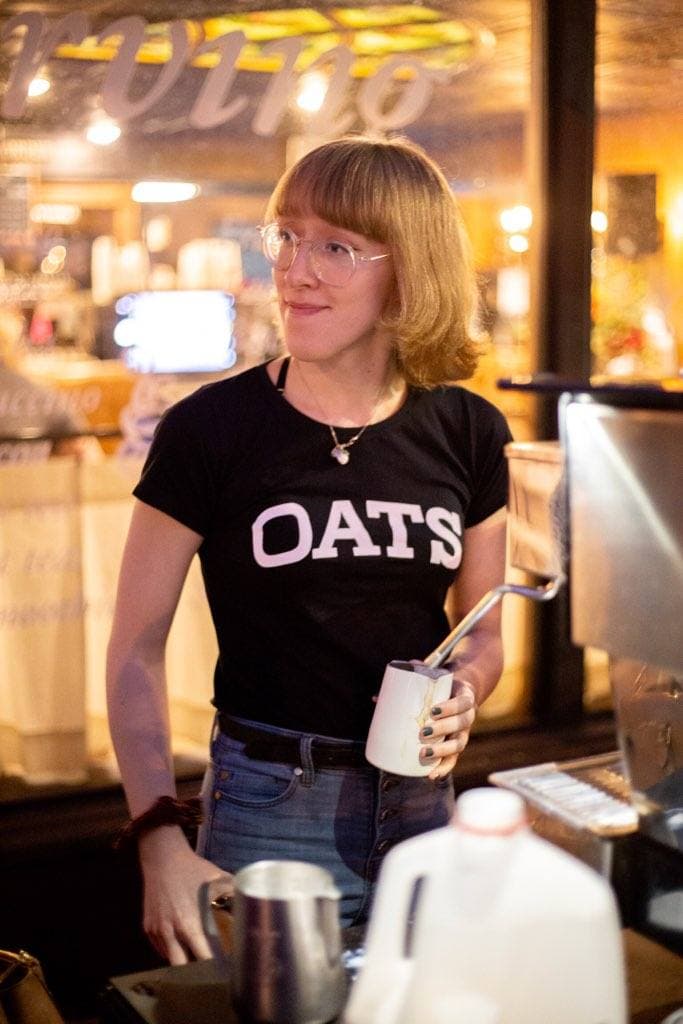
Bean barista gathering national recognition with caffeinated creations
When she was 19, Eve Wieser bought her first drip-coffee pot and forced herself to “get used” to the flavor. Now, not only does she enjoy the flavor of coffee – she’s turned the art form into a career one latte art competition at a time.
Wieser began creating art through coffee nine months ago. Since, she’s competed in competition across the midwest, and, most recently, she won the Ladies who Latte competition in Minneapolis on Sept. 19.
Weiser said it took six months to master the technics of latte art – created by pouring steamed milk in espresso shots to create pictures, such as hearts or tulips, which she specializes in.
Her first three months were “depressing” because of the difficulty behind dispersing the milk, she said, but said anyone interested in the art must “push through.”
“No matter how good you’ll be, you won’t be able to pour anything. So it’s important to be gentle with yourself to let yourself grow,” Weiser said.
Weiser began her coffee career two years ago when she started as a barista at The Bean in downtown Vermillion. A year later, Chrisobol Fancisquez, an experienced barista who’d competed in multiple latte art competitions, joined Weiser behind the counter.
Weiser said what made Francisquez a great teacher was his balance between encouragement and constructive criticism.
“I pushed her and was like ‘you have nothing to lose, you have more to gain,’” Francisquez said. “Now, I’ve seen her improve as both a person and as a barista.”
Going into the Ladies who Latte competition, Weiser said her goal was to place top three. Winning, she said, was a shock that brought confidence.
“I have been putting in a lot of work but I only started doing latte art about nine months ago and … now I feel like I’ve finally started to hit a stride,” Weiser said. “I had no idea that I could win, so when I did win it was really amazing.”
Latte art competitions usually include 32 competitors organized on a bracket. Each round features different pours, such as 10-ounce pours or 16-ounce pours. During each round, two baristas are paired up and then complete their design. Then, judges decided who will move on and who is eliminated.
“At the (competition) in Minneapolis… we could pour whatever design or style we wanted but we had to pour 10-ounce lattes,” Weiser explained. “Then baristas pour their design and set it in front of three judges and the
Sometimes, Weiser said, the competitions come down to luck. She said her fourth-place finish at a competition in Des Moines, Iowa earlier this year came from a majority of luck.
“The first round I was going up against an absolutely amazing barista … but she accidentally overfilled her cup and it kind of spilled over,” Weiser said. “That is just sort of the stuff that happens at latte art competitions.”
With more latte competition experience, Weiser is expanding to barista competitions. She will compete at the United States Barista competition qualifier in January.
To prepare, she applied and was accepted to the Glitter Cat “boot
From the 60 applicants for this year’s camp, Weiser was one of 10 selected.
“When I got in, I cried. I kept checking my email after they sent it to me. I kept waiting for them to say, ‘sike, you didn’t get in,’” Weiser said.
A barista competition is different from a latte art competition, Weiser said. A latte art competition is focused more on the aesthetic of coffee, while a barista competition is about taste, technics and presentation.
“Barista competition – you can think of it as a presentation and speech,” Weiser said.
Each competitor has 15 minutes for their presentation. During that time, they must prepare an espresso shot, cappuccino and signature drink for each of the four judges. While preparing the drinks, contestants must present the theme and explanation of their drinks, all while two technical judges watch them and rank their technical skills.
“It’s really intense, which is why I’m really excited to go to this bootcamp to develop these skills,” Weiser said.
Although she is still new to coffee competitions, Weiser said she won’t do them forever. She hopes to one day end up working in different aspects of coffee, such as a coffee consultant for shops and corporations.
Competitions, along with accolades, allow her to connect with the coffee world to open these windows.
“I do competitions sort of as a way to connect with the wider community of coffee,” Weiser said. “(Competitions allow me to build) connections with people in coffee I can ask questions and be friends with.”
For now, Weiser is still perfecting her skills at The Bean but said she enjoys traveling to other coffee shops to learn as much as she can to prepare her for future career opportunities.
At every coffee shop she visits, she tries their beans, asks questions and notes the overall experience. She said working at The Bean has been a great experience, but it isn’t her end goal.
“I love the Bean but I don’t think Vermillion is my forever place,” Weiser said. “There are lots of really amazing shops out there, so I think I might branch … but it really just depends on the opportunities I find.”

